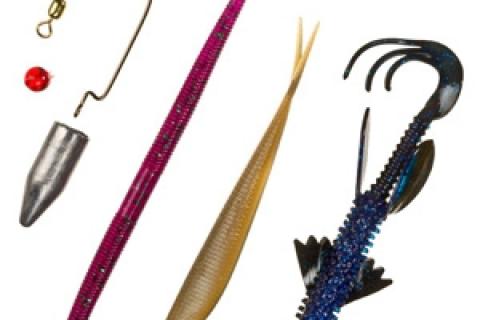
Fishermen throughout the South recognize the Carolina-rigged plastic worm as one of the most efficient, most versatile bass catchers ever devised. This combination of weight, swivel, leader and bait can be fished in a wide range of spots and circumstances. It is also extremely simple to use — beginners can pick up on it in no time.
 |
However, most anglers can benefit by taking their Carolina-rigging efforts one plane higher by fine-tuning them to specific fishing situations. Peter Thliveros, a bass pro from Jacksonville, Fla., says anglers Carolina-rigging with worms only are missing a lot of action they could enjoy if they would change the menu. "In fact, I rarely rig with standard worms anymore," Thliveros notes. "Mostly I use other baits that are specially suited to conditions I encounter from one day to the next."
For starters, Thliveros says there are two main concepts in Carolina-rigging: Large baits and heavy tackle when bass are feeding, and smaller, finesse baits/rigs on lighter tackle for fish that are more hesitant about eating.
First, the large baits. "This is sort of Carolina rig 'power-fishing'," Thliveros explains. "It's best when bass are actively chasing prey — when the bite's hot. Bigger baits like a plastic lizard or crawfish will draw strikes from better quality fish." Thliveros explains that warm, stained water and pre-frontal weather (overcast sky) are typical conditions for the larger baits.
For the heavy work, Thliveros uses a 7-foot medium-action baitcasting rod and a reel spooled with 20-pound test line. To rig, he runs a 1-ounce bullet weight up the line, follows this with a plastic bead, then ties on a brass two-way swivel. On the other end of the swivel, Thliveros ties a 4- to 7-foot length of monofilament leader in 12- or 16-pound test. He adds a 2-ought High Performance hook on the end, then he threads on a lizard or crawfish.
"I try both baits to see which one the fish want the most," Thliveros explains. "If I'm fishing around rocks, I'll probably start with a crawfish. If I'm fishing wood or grass, I'll go with the lizard. But I'll always try both to see if the bass have a preference. There's no set rule for this."
 |
| Another variation is a floating minnow bait used in place of a worm, lizard or craw. |
Thliveros rigs both these baits with a "Tex-posed" hook, which is run completely through the body, then the exposed point is reinserted slightly into the plastic body. "This way it's still weedless, but you don't have to pull the point all the way through the bait to set the hook," Thliveros explains.
If the bite is slow, however, Thliveros shifts from this larger rig to a finesse rig — same Carolina concept, just downsized. He makes this adjustment when the water is clear, fishing pressure is heavy, a cold front has blown through (bright sky) or under any other condition that has bass off their feed.
"For finesse-rigging I use a 6-1/2 or 7-foot spinning rod and 10-14 pound test line. Also, I go with two different rigs. In current I'll stick with the 1 ounce sinker and the same swivel, but I'll change to a smaller leader, bait and hook. For instance, I'll use an 8- or 10-pound test leader, a #1 hook and a 4-inch Luck-E-Strike Ring Worm or 4- or 7-inch Luck-E-Strike Razor Worm."
When even more finesse is needed, Thliveros opts for a split-shot rig, which offers an extra degree of subtlety. "Now I'll use 8-12 pound test, and I'll peg a 3/16 or 1/8-ounce slip sinker a foot above my hook. Then I'll rig with a Ring Worm, a small Razor Worm or even a curltail grub, and I'll drag this slowly across the bottom in up to 10 feet of water. This is a real good way to catch spooky bass."
Other variations of the Carolina rig are available to anglers with a yen to try something different. One is a tube bait rigged behind a light sinker. Insert a small piece of Styrofoam into the body of the tube so it will float up off bottom. Also, push a chunk of Alka-Seltzer into the body so it will fizz and bubble during the retrieve.
Another variation is a floating minnow bait used in place of a worm, lizard or craw. An angler using this rig can fish a lure like a Rapala or Rebel Minnow as deep as he wants, pulling then stopping the bait so it hangs tantalizingly in the strike zone.
In summary, the important thing is for bass fishermen to understand the Carolina rig for what it truly is: a system for offering different baits to bass in a variety of situations. Carolina-riggers have broad latitude for experimentation, and as Peter Thliveros points out, sometimes small changes can make big differences in the number of fish that are boated with this rig.
- 25141 views

